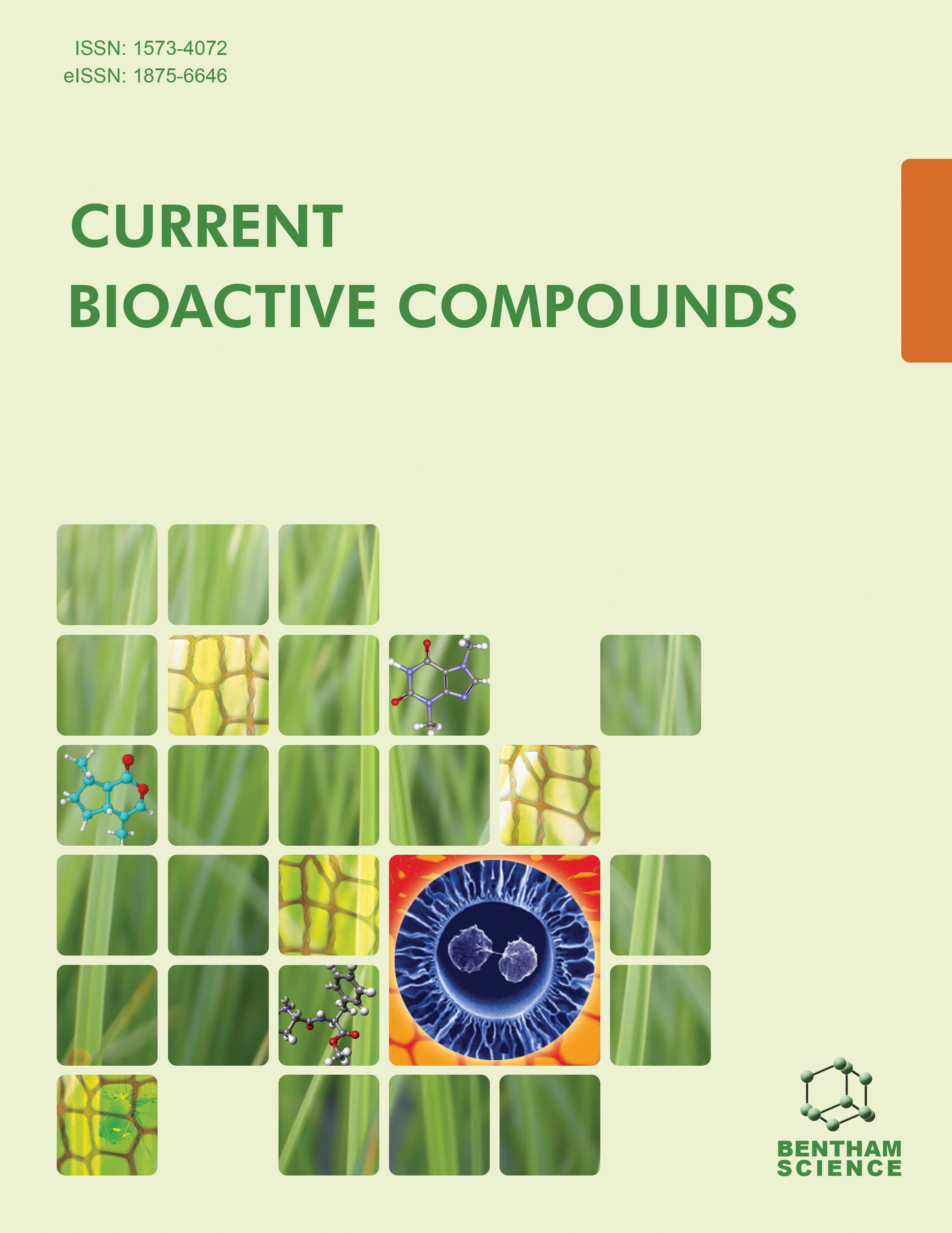- Home
- A-Z Publications
- Current Bioactive Compounds
- Previous Issues
- Volume 7, Issue 1, 2011
Current Bioactive Compounds - Volume 7, Issue 1, 2011
Volume 7, Issue 1, 2011
-
-
Editorial [Hot Topic: Anticancer Macromolecular Prodrugs in Clinical Trials - an Update (Guest Editor: Felix Kratz)]
More LessBy Felix KratzPROLOGUE Coupling of low-molecular weight anticancer drugs to synthetic polymers or serum proteins through a cleavable linker has been an effective method for improving their therapeutic index through active and targeting approaches and convincing proofof- concepts have been obtained preclinically for a substantial number of prodrug candidates [1]. Drug conjugates with synthetic polymers or serum proteins th Read More
-
-
-
EZN-2208 (PEG-SN38), A 40 kDa Polyethylene Glycol (PEG) Conjugate, As an Anticancer Agent: Review of Preclinical and Clinical Data
More LessBy Hong ZhaoEZN-2208 (PEG-SN38) is a polymeric prodrug of anticancer agent SN38 (7-ethyl-10-hydroxyl-camptothecin) which is prepared by coupling a 40 kDa, 4-arm polyethylene glycol (PEG) with SN38, through a glycine spacer. The coupling strategy was developed to selectively link the 20-OH group of SN38, thus stabilizing the E-ring of SN38 in the active lactone form. EZN-2208 markedly increased the solubility of SN38 by about 1,000 f Read More
-
-
-
CRLX101 (formerly IT-101) A Novel Nanopharmaceutical of Camptothecin in Clinical Development
More LessAuthors: Cissy Young, Thomas Schluep, Jungyeon Hwang and Scott EliasofCRLX101 (formerly IT-101) is a first-in-class nanopharmaceutical, currently in Phase 2a development, which has been developed by covalently conjugating camptothecin (CPT) to a linear, cyclodextrin-polyethylene glycol (CDPEG) co-polymer that self-assembles into nanoparticles. As a nanometer-scale drug carrier system, the cyclodextrin polymeric nanoparticle technology, referred to as “CDP”, has unique design featu Read More
-
-
-
XMT-1001, A Novel Biodegradable Polyacetal Polymer Conjugate of Camptothecin in Clinical Development
More LessAuthors: A. V. Yurkovetskiy and R. J. FramXMT-1001 is a conjugate of camptothecin (CPT) and Fleximer®, a biodegradable stealth polymer (poly [1- hydroxymethylethylene hydroxymethylformal], also called PHF). CPT is covalently linked to PHF via a hydrolizable linker. The conjugation of CPT with PHF increases the solubility of CPT. XMT-1001 releases CPT via intermediates camptothecin-20-O-(N-succinimidoglycinate) (CPT-SI) and camptothecin-20-O Read More
-
-
-
AP5346 (ProLindac™), A DACH Platinum Polymer Conjugate in Phase II Trials Against Ovarian Cancer
More LessProLindac™ (AP5346) is a 25 kDa polymer delivery vehicle based on hydroxypropylmethacrylamide (HPMA) to which DACH (diaminocyclohexane) platinum is bound. DACH platinum is the active moiety in the approved chemotherapeutic, oxaliplatin. The AP5346 polymer prodrug is currently in phase II clinical development. The polymer targets the drug to tumors and a pH-sensitive linker releases platinum more rapidly in low pH Read More
-
-
-
ONCOFID™-P a Hyaluronic Acid Paclitaxel Conjugate for the Treatment of Refractory Bladder Cancer and Peritoneal Carcinosis
More LessAuthors: Monica Campisi and Davide RenierHyaluronan receptors (CD44, RHAMM) are over-expressed in a wide variety of cancers including bladder and ovarian tumors. Based on this rationale, a hyaluronic acid paclitaxel conjugate, ONCOFID™-P, was developed for the treatment of refractory bladder cancer and peritoneal carcinosis. ONCOFID™-P has demonstrated improved in vitro and in vivo efficacy in hyaluronan receptor-positive tumor models and a fa Read More
-
-
-
INNO-206 (DOXO-EMCH), an Albumin-Binding Prodrug of Doxorubicin Under Development for Phase II Studies
More LessBy F. KratzThe (6-maleimidocaproyl)hydrazone derivative of doxorubicin (INNO-206, formerly DOXO-EMCH) is a prodrug of the anticancer agent doxorubicin which is selectively bound to the cysteine-34 position of endogenous albumin within a few minutes after intravenous administration planned for 2011. Preclinically as well as clinically, the albuminbound form of INNO-206 has a large AUC, a small volume of distribution and low clear Read More
-
-
-
A Randomized, Double Blind, Controlled, Dose Dependent Clinical Trial to Evaluate the Efficacy of a Proanthocyanidin Standardized Whole Cranberry (Vaccinium macrocarpon) Powder on Infections of the Urinary Tract
More LessAuthors: K. Sengupta, K. V. Alluri, T. Golakoti, G. V. Gottumukkala, J. Raavi, L. Kotchrlakota, S. C. Sigalan, D. Dey, S. Ghosh and A. ChatterjeeUrinary tract infections (UTIs) represent a recurrent health problem especially for women. More than 50% of women will suffer from a UTI at least once in their lifetime. Cranberries have long been used for their beneficial effects in preventing symptomatic UTIs in several published studies. However, cranberry products used in these clinical studies do not indicate the amount of active ingredients delivered that help to preven Read More
-
-
-
Chemistry and Biological Activities of Buxus Alkaloids
More LessAuthors: Yu-Xin Yan, Yun Sun, Zhong-Rong Li, Lin Zhou and Ming-Hua QiuTriterpenoid alkaloids are one of the most important classes that have been studied. Buxus alkaloids are such a type of triterpenoid alkaloids of cycloartenol skeleton with a degraded C-20 side chain, and with the nitrogen containing substituents at C-3 and/or C-20. 219 Buxus alkaloids have been reported so far. This review article focuses on the structural characters, plant sources and biological activities of Buxus alkaloids. T Read More
-
Volumes & issues
-
Volume 21 (2025)
-
Volume 20 (2024)
-
Volume 19 (2023)
-
Volume 18 (2022)
-
Volume 17 (2021)
-
Volume 16 (2020)
-
Volume 15 (2019)
-
Volume 14 (2018)
-
Volume 13 (2017)
-
Volume 12 (2016)
-
Volume 11 (2015)
-
Volume 10 (2014)
-
Volume 9 (2013)
-
Volume 8 (2012)
-
Volume 7 (2011)
-
Volume 6 (2010)
-
Volume 5 (2009)
-
Volume 4 (2008)
-
Volume 3 (2007)
-
Volume 2 (2006)
-
Volume 1 (2005)
Most Read This Month
Article
content/journals/cbc
Journal
10
5
false
en

Most Cited Most Cited RSS feed
-
-
Podophyllotoxin: Current Perspectives
Authors: Ying Qian Liu, Liu Yang and Xuan Tian
-
- More Less

